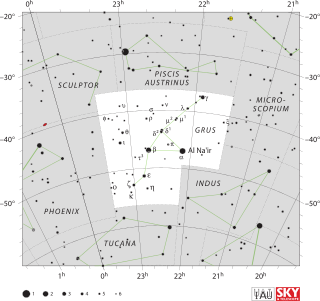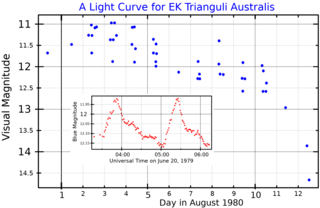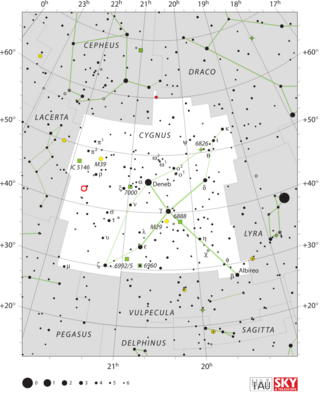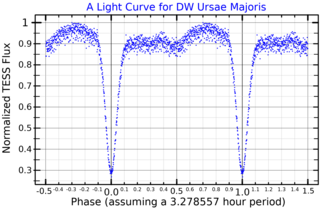
Grus is a constellation in the southern sky. Its name is Latin for the crane, a type of bird. It is one of twelve constellations conceived by Petrus Plancius from the observations of Pieter Dirkszoon Keyser and Frederick de Houtman. Grus first appeared on a 35-centimetre-diameter (14-inch) celestial globe published in 1598 in Amsterdam by Plancius and Jodocus Hondius and was depicted in Johann Bayer's star atlas Uranometria of 1603. French explorer and astronomer Nicolas-Louis de Lacaille gave Bayer designations to its stars in 1756, some of which had been previously considered part of the neighbouring constellation Piscis Austrinus. The constellations Grus, Pavo, Phoenix and Tucana are collectively known as the "Southern Birds".

A U Geminorum-type variable star, or dwarf nova is one of several types of cataclysmic variable star, consisting of a close binary star system in which one of the components is a white dwarf that accretes matter from its companion. Dwarf novae are dimmer and repeat more frequently than "classical" novae.

AM Herculis is a binary variable star located in the constellation Hercules. This star, along with the star AN Ursae Majoris, is the prototype for a category of cataclysmic variable stars called polars, or AM Her type stars.

WZ Sagittae is a cataclysmic dwarf nova star system in the constellation Sagitta. It consists of a white dwarf primary being orbited by a low mass companion. The white dwarf is about 0.85 solar masses while the companion is only 0.08 solar masses. This implies that the companion is a spectral class L2 star, although this has yet to be confirmed. The distance to this system has been determined by parallax, yielding a distance of 45.1 parsecs.

EK Trianguli Australis is a star in the constellation Triangulum Australe. It is a dwarf nova of the SU Ursae Majoris type that officially classified as such in 1980, after the characteristic eruptions of a short eruption and a supereruption were observed in May 1978 and June 1979 respectively. These systems are characterised by frequent eruptions and less frequent supereruptions. The former are smooth, while the latter exhibit short "superhumps" of heightened activity. The distance of the system has been assumed at 180 parsecs from the Solar System, for the donor star. Spectroscopic analysis and calculation gave an estimate of 125 parsecs.

SX Leonis Minoris is a dwarf nova of the SU Ursae Majoris type that was first discovered as a 16th magnitude blue star in 1957, before its identity was confirmed as a dwarf nova in 1994. The system consists of a white dwarf and a donor star which orbit around a common centre of gravity every 97 minutes. The white dwarf sucks matter from the other star via its Roche lobe onto an accretion disc which is heated to between 6000 and 10000 K and periodically erupts every 34 to 64 days, reaching magnitude 13.4 in these outbursts and remaining at magnitude 16.8 when quiet. These outbursts can be split into frequent eruptions and less frequent supereruptions. The former are smooth, while the latter exhibit short "superhumps" of heightened activity and last 2.6% longer.

CE Gruis is a faint binary star system in the constellation Grus. It is a variable star, with a B-band brightness that ranges from a peak magnitude of 17.4 down to a minimum of 19.5 over a period of 108.6 minutes. The system is composed of a white dwarf and donor star, locked into a close, synchronous orbit. In such systems, known as polars, material from the donor star does not form an accretion disc around the white dwarf because of its intense magnetic field, but rather streams directly onto it along columns.
SW Sextantis variable stars are a kind of cataclysmic variable star; they are double-star systems in which there is mass transfer from a red dwarf to a white dwarf forming a stable accretion disc around the latter. Unlike other non-magnetic cataclysmic variables, the emission lines from hydrogen and helium are not doubled, except briefly near phase 0.5.

Q Cygni, is a star located in the constellation Cygnus. It is also known as Nova Cygni 1876, and has the designation NGC 7114, and HR 8296. Nova Cygni is located in the northwestern portion of Cygnus along the border with Lacerta.

TV Corvi, also known as Tombaugh's Star, is a dwarf nova of the SU Ursae Majoris type in the constellation Corvus that was first discovered by accident as a mysterious 12th magnitude star on a plate by Clyde Tombaugh while looking for remote planets on May 25, 1932, before its identity was confirmed as a dwarf nova by David Levy in 1990.

In astronomy, a superhump is a periodic brightness variation in a cataclysmic variable star system, with a period within a few percent of the orbital period of the system.

SU Ursae Majoris, or SU UMa, is a close binary star in the northern circumpolar constellation of Ursa Major. It is a periodic cataclysmic variable that varies in magnitude from a peak of 10.8 down to a base of 14.96. The distance to this system, as determined from its annual parallax shift of 4.53 mas, is 719 light-years. It is moving further from the Earth with a heliocentric radial velocity of +27 km/s.

LL Andromedae is a dwarf nova in the constellation Andromeda, discovered during an outburst in 1979. Its typical apparent visual magnitude is 19.4, but undergoes outbursts events when can reach a peak magnitude of 14.3. Since this magnitude is reached during the most powerful outbursts, while less bright outbursts can occur, it is classified as a SU Ursae Majoris variable.

V1315 Aquilae is a cataclysmic variable star in the north of the equatorial constellation of Aquila. It is in the sub-set of nova-like (NL) variables, specifically a SW Sextantis star. These were characterized as having non-magnetic white dwarfs – thus that do not undergo dwarf-nova bright luminations ("eruptions"). There is countering evidence for some magnetism. Being a SW Sextantis star, V1315 Aquilae has a high rate of mass transfer, so it is in steady-state accretion and in a constant state of outburst. It emits most of its light in the visible range, and this comes from the accretion disk. The eclipse depth is 1.8 mag. No description of the donor star is made.

UX Ursae Majoris is an Algol type binary star system in the northern circumpolar constellation of Ursa Major. It is classified as a nova-like variable star similar to DQ Herculis, although no eruptions have been reported. Since its discovery in 1933, this system has been the subject of numerous studies attempting to determine its properties. The combined apparent visual magnitude of UX UMa ranges from 12.57 down to 14.15. The system is located at a distance of approximately 952 light years from the Sun based on parallax, and is drifting further away with a radial velocity of 112 km/s.

BZ Ursae Majoris is a dwarf nova star system in the northern circumpolar constellation of Ursa Major. It consists of a white dwarf primary in a close orbit with a red dwarf. The latter star is donating mass, which is accumulating in an accretion disk orbiting the white dwarf. The system is located at a distance of approximately 505 light years from the Sun based on parallax measurements.

RZ Leonis Minoris is a cataclysmic variable star system in the northern constellation of Leo Minor. It undergoes frequent outbursts that vary in brightness from an apparent visual magnitude of 14.4 down to 16.8. Based on parallax measurements, this system is located at a distance of approximately 2,160 light years from the Sun.

SW Ursae Majoris is a cataclysmic binary star system in the northern circumpolar constellation of Ursa Major, abbreviated SW UMa. During quiescence it has an apparent visual magnitude of 16.5–17, which is too faint to be visible to the naked eye. Based on parallax measurements, it is located at a distance of approximately 526 light years from the Sun.

DW Ursae Majoris is an eclipsing binary star system in the northern circumpolar constellation of Ursa Major, abbreviated DW UMa. It is a cataclysmic variable of the SX Sextanis type, consisting of a compact white dwarf that is accreting matter from an orbiting companion star. The brightness of this source ranges from an apparent visual magnitude of 13.6 down to magnitude 18, which is too faint to be viewed with the naked eye. The distance to this system is approximately 1,920 light years based on parallax measurements.

ER Ursae Majoris is a variable star in the northern circumpolar constellation of Ursa Major, abbreviated ER UMa. It is a prototype system for a subclass of SU Ursae Majoris dwarf novae. The system ranges in brightness from a peak apparent visual magnitude of 12.4 down to 15.2, which is too faint to be visible to the naked eye. The distance to this system, based on parallax measurements, is approximately 1,163 light years.



















